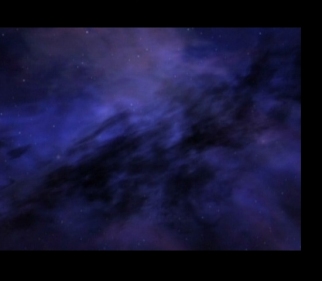|

In Star Trek, a black cluster is a type of cluster that
is created when numerous protostars collapsed in close proximity to one
another. The result of this collective collapse was an area of space
that absorbs energy and dangerously affects spacecraft systems. In
2368, the SS Vico was assigned to explore a black cluster, located in
Sector 97. This particular cluster that was formed about 9 billion
years ago, from hundreds of collapsed protostars, and was seven times
more massive than any black cluster that had been previously sighted.
After Starbase 514 lost contact with the Vico the USS Enterprise-D was
sent to investigate. Upon its' arrival on the edge of this black
cluster, the destroyed hulk of the Vico was immediately found. The
Enterprise itself was almost destroyed while further investigating the
Vico's disappearance. (TNG: "Hero Worship").
The Federation space station Deep Space 3 is located
near a black cluster. (TNG: "Interface")
There are no 'black clusters' in real astronomy. When
proto-stars collapse, they get hotter and may be formed into true
stars. A proto-star is a star that has not yet initiated fusion. Stars
begin their life as a cool cloud of gas. Under its own gravity, the
cloud begins to collapse. As it collapses, it releases its
gravitational energy as radiation. So a young star is cool but bright.
We usually don't see these proto-stars, however, because they are
generally shrouded in dust and only give off light in the far infrared
part of the spectrum. The proto-star continues to collapse, and as it
does, it gets hotter and hotter. "Stars" less than a percent of the
Sun's mass eventually halt their collapse due to gas pressure. These
stars are "brown dwarfs" or "giant planets," like Jupiter. They never
ignite their hydrogen, and gradually dim away.
Stars larger than about 0.05 to 0.07 solar masses
contract, getting hotter and hotter, until their cores are hot enough
to begin burning hydrogen. When a star "turns on" its hydrogen-burning
phase, we say that it has reached the main sequence, and is a true
star, not a protostar, brown dwarf, or planet.
While there are no 'dark clusters', there are dark
nebulae - a type of interstellar cloud that is so dense that it
obscures the light from the background emission or reflection nebula
(e.g., the Horsehead Nebula) or that it blocks out background stars
(e.g., the Coalsack Nebula). The extinction of the light is caused by
interstellar dust grains located in the coldest, densest parts of
larger molecular clouds. Clusters and large complexes of dark nebulae
are associated with Giant Molecular Clouds. Isolated small dark nebulae
are called Bok globules. The form of such dark clouds is very
irregular: they have no clearly defined outer boundaries and sometimes
take on convoluted serpentine shapes. The largest dark nebulae are
visible to the naked eye, appearing as dark patches against the
brighter background of the Milky Way. In the inner regions of dark
nebulae important events take place, such as the formation of stars and
masers.
|
|
